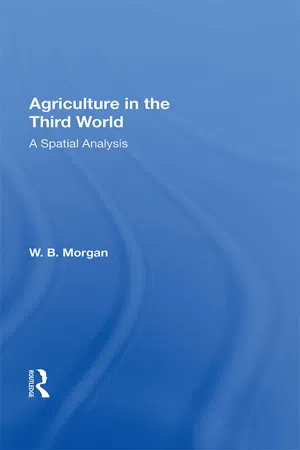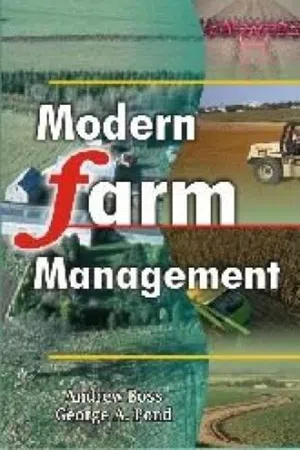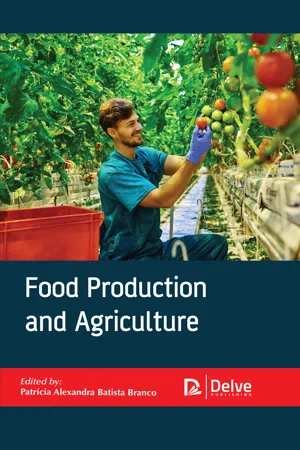Geography
Agricultural Production Regions
Agricultural production regions are geographic areas where specific crops or livestock are cultivated or raised. These regions are characterized by their suitability for certain types of agriculture due to factors such as climate, soil, and topography. They play a crucial role in global food production and trade, shaping the agricultural landscape and influencing economic and social dynamics.
Written by Perlego with AI-assistance
Related key terms
1 of 5
6 Key excerpts on "Agricultural Production Regions"
- eBook - ePub
- W. B. Morgan(Author)
- 2019(Publication Date)
- Routledge(Publisher)
4Agricultural regions in the Third WorldIn the more developed countries agricultural regions are mostly seen as areas of specialization in the production of a particular farm enterprise or group of enterprises; spectacularly so in the United States, where, as early as the 1920s, huge areas of major crop or livestock production concentration were generally recognized and more formally defined by O. E. Baker (1926–32). Agricultural regions are not discrete objects totally integrating all the phenomena lying within their bounds, nor do they necessarily possess a very high degree of homogeneity of some combination of phenomena, nor are they the inevitable product of the operation of ‘natural laws’. They are a convenient way of dividing and classifying space with respect to certain phenomena in order to create a simplified picture of the spatial patterning of agricultural activity (Morgan and Munton, 1971, pp. 126–8). They are essentially an intellectual concept (Whittlesey, 1954) or the product of imagination, but based on real facts of spatial concentration interpreted by partial and sometimes indirect measures of varying degrees of accuracy. Frequently they do contain distinctive landscape features, more especially distinctive patterns of land use, field systems and settlement, but there are few instances of even approximate exclusive co-variation of three or more phenomena of agricultural significance. Significantly, the regions include many features displayed elsewhere and their key criteria are often represented in other locations. Few of them are the product of some centrally-directed plan; most have resulted from the similar decisions of large numbers of farmers living near to one another. We may therefore see many regions as the result not just of particular combinations of factors for which a certain enterprise or particular form of agricultural activity provided a preferred or supposedly optimal farming choice, but as the result of a particular spread or diffusion of information, advice and example. Agricultural regions may be seen to increase or decrease in size, to change their degree of concentration of a particular enterprise or even apparently to move across country. They may also change in shape, split into a number of discrete areas or fuse a number of separate areas together. Although we cannot for the most part identify a particular decision-maker such as a farmer or a government minister with them, as we can with the farm or the nation, nevertheless these are important areal units for consideration in any agricultural study, for they are the product of particular patterns of decision-making, of flows of information and of other spatial systems such as networks of social relationships, of transport and of marketing. They are the spatial expression of organized agricultural activity. - eBook - PDF
Farming, Development and Space
A World Agricultural Geography
- Bernd Andreae, Howard F. Gregor(Authors)
- 2013(Publication Date)
- De Gruyter(Publisher)
232 VIII. The Agricultural Geography of the Middle Latitudes Climates in the area of the Common Market of the Nine range from a Central European transitional type to a pronounced oceanic type, and from mountain varieties to the Mediterranean and subtropical types. The area thus offers the most varied conditions for agricultural produc-tion, as well as an extraordinary diversity of farming types. Their region-al distribution was presented in a series of maps, based on a newly developed classification. The agricultural regions that were delimited almost completely blot out the international boundaries. This is an indication of the dominance of the ecological factors over the economic qualifications of production. Consequently it is not primarily the overall national agricultural econo-mies of the European Community that compete across the frontiers, but rather the farming types and agricultural regions that are conditioned by the same physical elements. 2. The Agricultural Geography of North America The treatment of the agricultural geography of North America will be essentially confined to the United States. The total national area will be considered, though the western part (approximately west of the 100th meridian) is classed with the dry areas and therefore was partly discussed in part in Chapter VII. The large Canadian area will only occasionally be referred to since the agricultural geography of its southern provinces resembles that of northern U.S. (see Fig. 13, p. 61), while the agricultural-geographic conditions in northern Canada duplicate those of northern Scandinavia and northern Russia: forest regions with scattered fodder cropping farms concentrat-ing on ley farming, followed by forest and shrub regions, and finally transition to the tundra. - Boss, Andrew(Authors)
- 2021(Publication Date)
- Biotech(Publisher)
Chapter 5 Agricultural Production Areas Why is it that most of the oranges are grown in California and Florida? Why is it that the farmers of the South do not raise sufficient wheat and corn for their own needs? Why is it that cotton, peanuts, and sweet potatoes are not grown in the North Central states? Why is it difficult to grow peaches, pears, and apricots in Minnesota or Wisconsin? Why is wheat the principal cereal crop in the Great- Plains area? Why does the state of Iowa grow so much corn? The answers to these questions and many others will be found in a study of the varying physical conditions prevailing in the different parts of the United States. Close examination and analysis of the Figures shown in this chapter will reveal many interesting facts about the agriculture of the United States. Physical Conditions Determine Production Physical conditions have a fundamental influence in determining where the various agricultural crops and commodities may be successfully grown. These physical factors are fixed and unalterable. While there may be variations in some of these factors at times, they are, in the long run, quite beyond permanent change or human control. They have been classified into four principal groups as follows: 1 Moisture Conditions These include rainfall, snowfall, hail, fog, humidity, and rate of evaporation. This ebook is exclusively for this university only. Cannot be resold/distributed. Temperature Conditions These cover temperature ranges, through the growing season and particularly the dates of spring and fall frosts. Topography or Land Form This covers the levelness or roughness of the earth’s surface, the degree of slope on side hills and the general form of the earth’s surface. Soil Conditions Soil conditions include physical structure and chemical and bacteriological characteristics. Moisture and temperature determine the climate or atmospheric conditions of a region.- eBook - PDF
A Geography of the Soviet Union
Pergamon Oxford Geographies
- John C. Dewdney, W. B. Fisher(Authors)
- 2013(Publication Date)
- Pergamon(Publisher)
18. FIG. 19. (A) Generalised distribution of agricultural land. Main areas of (B) wheat, (C) barley and (D) rye cultivation. The heavier shading on each map denotes the areas of most intensive production. 65 FIG. 20. Main areas of (A) oats, (Β) maize and rice, (C) potatoes and (D) sugar-beet cultivation. The heavier shading on each map denotes the areas of most intensive production. 66 FIG. 21. Main areas of (A) sunflower, (Β) cotton and flax, (C) tobacco and hemp and (D) grapes, tea and citrus fruits, and soya-bean cultivation. The heavier shading on each map denotes the areas of most intensive production. 67 68 A Geography of the Soviet Union AGRICULTURAL REGIONS T h e division of an area as large as the Soviet Union into agricultural regions presents serious problems to the economic geographer, not only in defining the regions themselves, but also in showing them on a m a p . Most Soviet textbooks of economic geography divide the U.S.S.R. into some twenty or thirty agricultural regions, n a m i n g each after its most important product or products. These are usually illustrated by a series of maps covering each major economic region separately and showing a great deal of detail. For this book it has been necessary to compress the great amount of detailed information available from Russian sources and to present a much simplified picture of the agricultural regions accompanied by a m a p of the whole country. This m a p (Fig. 23) distinguishes four major agricultural zones, each of which is divided into several regions, the latter n u m b e r i n g ten in all. It should be realized that each of these regions is by no means uniform and that there are considerable contrasts in the character of farming between different parts of a single region. It is felt, however, that the scheme presented here gives a reasonably accurate picture of the range of conditions to be found within the U.S.S.R. - eBook - PDF
- Patrícia Alexandra Batista Branco(Author)
- 2019(Publication Date)
- Delve Publishing(Publisher)
THE EFFECT OF ENVIRONMENTAL FACTORS AND CLIMATE CHANGE ON AGRICULTURAL FOOD PRODUCTION CONTENTS 8.1 Introduction ..................................................................................... 174 8.2 Environmental Factors ..................................................................... 174 8.3 Some Climatic Elements And Their Relationship to Farming Systems ........................................................................... 189 Chapter 8 Food Production and Agriculture 174 8.1 INTRODUCTION The logical subtleties in the environmental change domain are plentiful. In the dangerous atmospheric deviation (otherwise known as an environmental change) domain, there is a range of convictions among people in general. The individuals who tend to see these issues in dark or white terms, and who would prefer not to be bothered with understanding the points of interest of the global temperature rise have a tendency to incline toward either extreme. It is clear and evident that global warming is man-made and proper policy formations, as well as regulation, is required to deal with it as the consequences can be life-threatening. 8.2 ENVIRONMENTAL FACTORS Physical elements in any given place determine what a farmer can produce, how and when to produce. Certain ecologic parameters are possibly the most important factor for a farmer. These include: • Rainfall characteristics • Temperatures characteristics • Soils characteristics Of these parameters rainfall pattern, its distribution, reliability, intensity and effectiveness are the most significant factors. It is the main cause of uncertainties that surround the farmer’s decision-making environment. On the other hand, soils, the surface configuration of the land and temperatures are equally useful determinants of the farming activities at the regional level. However, some of these technical elements are difficult to quantify due to the paucity of accurate data. - eBook - ePub
- R. E. H. Mellor(Author)
- 2021(Publication Date)
- Routledge(Publisher)
CHAPTER 6Geography of AgricultureDOI: 10.4324/9781003172048-6ABOUT a fifth of the land area of the U.S.S.R. is used agriculturally, compared to over a half in the U.S.A. Immense areas of Siberia are suited only to forestry or herding with small patches of arable or meadow. In the poor steppe and semi-desert and the mountains of Soviet Central Asia, as well as in mountainous Caucasia and Southern Siberia, activity is limited to low density pastoralism. Despite large plains, winter cold and summer drought make successful crop raising hazardous, while low yield can be expected from great areas of soils of mediocre fertility in Northern European Russia and parts of Asiatic Russia. The Russian farmers' problems in a difficult physical environment have not been lessened by the tasks assigned them by the Soviet authorities.TABLE 8 AGRICULTURAL EMPLOYMENT 1939-1959The attempt to be as self-sufficient as possible has put the burden of feeding the people, an increasing proportion of whom live in towns, almost completely on home production, further taxed by rising living standards and the need to grow industrial crops. Mining and industrial development beyond the bounds of established food-producing areas, in sub-arctic Siberia and arid Central Asia, has made it desirable to grow food locally despite the unfavourable environment. Better strains of crops and livestock, mechanization, and improved husbandry have been sought to increase output as rural population and the share of agriculture in the employed population have fallen.PHYSICAL FACTORS AFFECTING AGRICULTURE
In a country composed essentially of lowlands, climate and soil rather than slope, aspect, or altitude are the principal factors which restrict expansion of the farmed area and hamper current farming. The great distances from the sea of much of the country mean a generally low precipitation and an important relationship between it and evaporation. In the north, the combination of low temperature with a moderate precipitation (15-20 inches) leads to water-logging of the ground, while in the south, hot summers and precipitation of 12-16 inches falling in spring and early summer create the necessity for careful moisture conservation, accentuated by the unreliability of the rainfall (Fig. 29). Indeed, from north to south, as the thermal regime becomes more favourable, precipitation decreases or occurs at seasons when its effectiveness is reduced by intense evaporation. Eastwards, increasing continentality shortens the growing season and the frost free period, while the rapid change between seasons reduces the planting and harvesting times. Long summer days in high latitudes help to offset some of these effects, but over half the country has a growing season of a hundred days or less, not all frost-free, and a widespread occurrence of permafrost.
Index pages curate the most relevant extracts from our library of academic textbooks. They’ve been created using an in-house natural language model (NLM), each adding context and meaning to key research topics.





